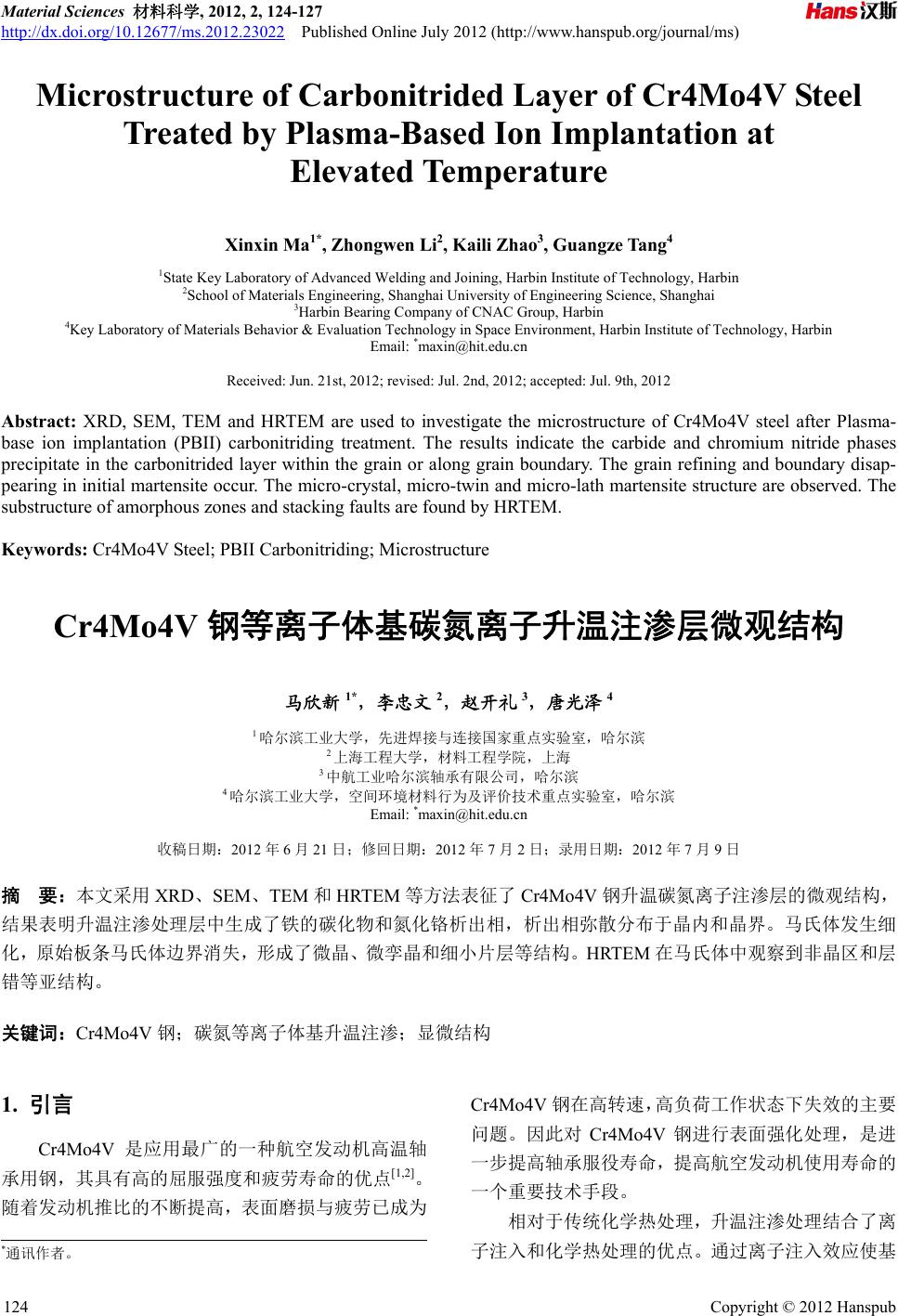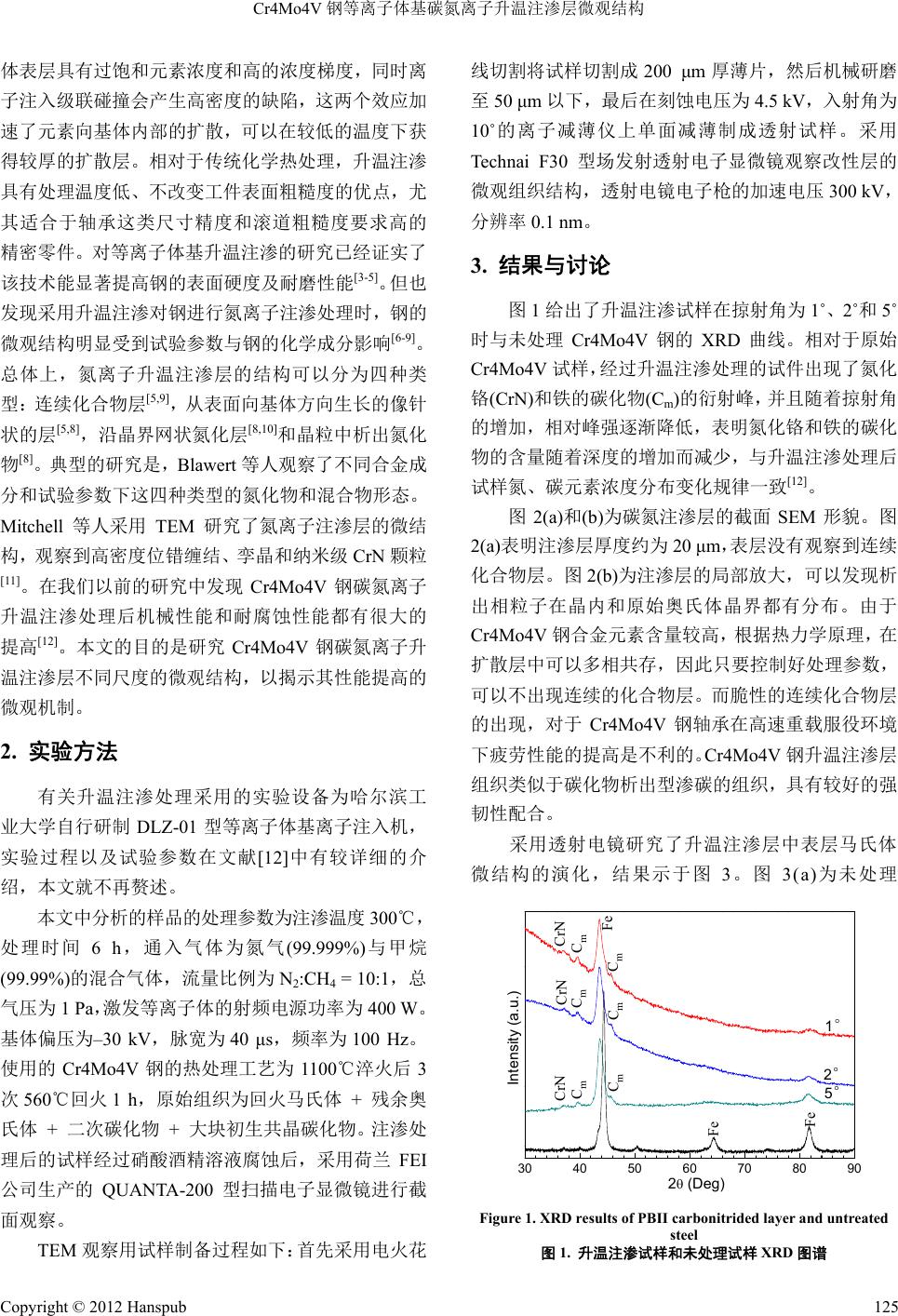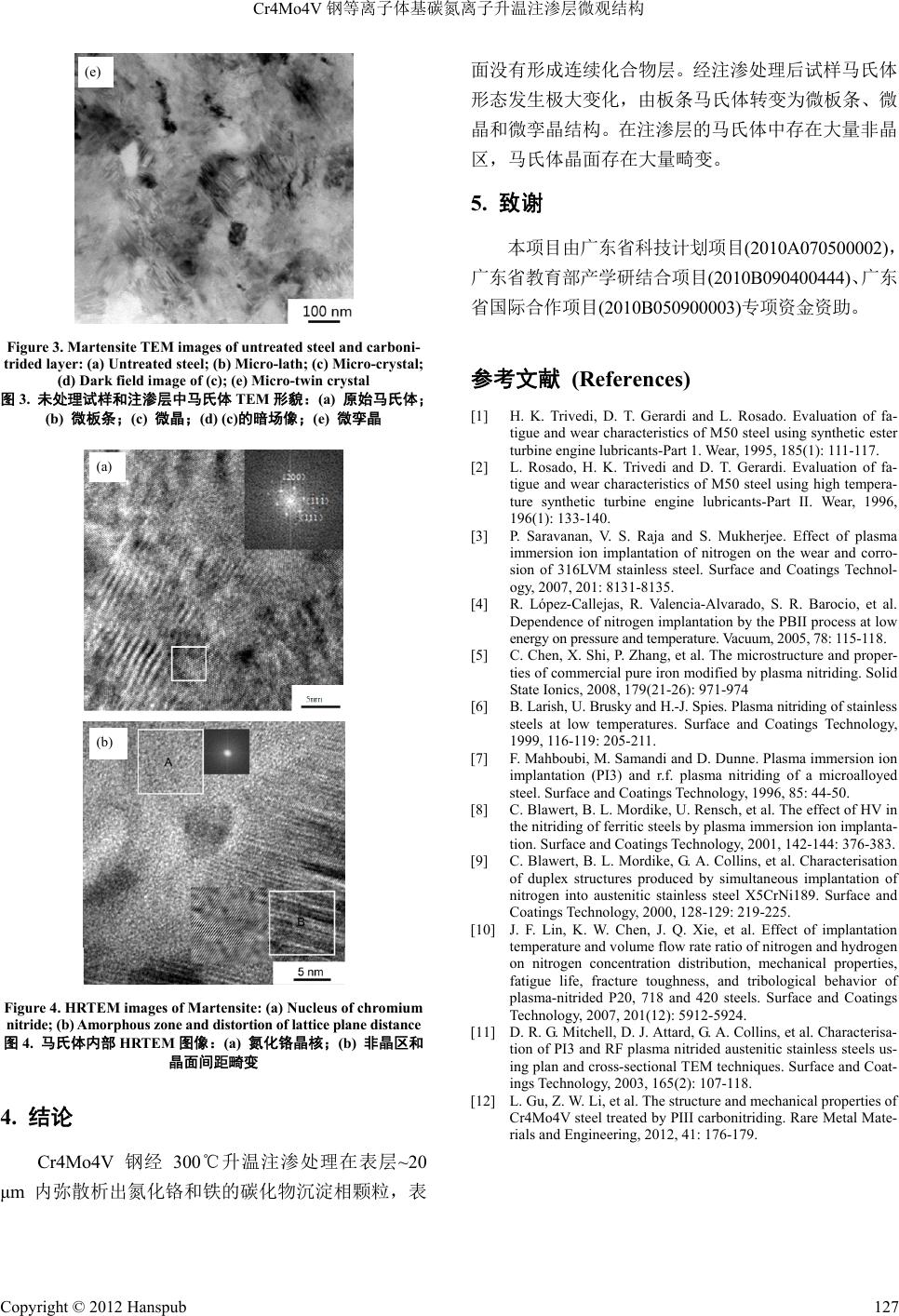 Material Sciences 材料科学, 2012, 2, 124-127 http://dx.doi.org/10.12677/ms.2012.23022 Published Online July 2012 (http://www.hanspub.org/journal/ms) Microstructure of Carbonitrided Layer of Cr4Mo4V Steel Treated by Plasma-Based Ion Implantation at Elevated Te mperature Xinxin Ma1*, Zhongwen Li2, Kaili Zhao3, Guangze Tang4 1State Key Laboratory of Advanced Welding and Joining, Harbin Institute of Technology, Harbin 2School of Materials Engineering, Shanghai University of Engineering Science, Shanghai 3Harbin Bearing Company of CNAC Group, Harbin 4Key Laboratory of Materials Behavior & Evaluation Technology in Space Environment, Harbin Institute of Technology, Harbin Email: *maxin@hit.edu.cn Received: Jun. 21st, 2012; revised: Jul. 2nd, 2012; accepted: Jul. 9th, 2012 Abstract: XRD, SEM, TEM and HRTEM are used to investigate the microstructure of Cr4Mo4V steel after Plasma- base ion implantation (PBII) carbonitriding treatment. The results indicate the carbide and chromium nitride phases precipitate in the carbonitrided layer within the grain or along grain boundary. The grain refining and boundary disap- pearing in initial martensite occur. The micro-crystal, micro-twin and micro-lath martensite structure are observed. The substructure of amorphous zones and stacking faults are found by HRTEM. Keywords: Cr4Mo4V Steel; PBII Carbonitriding; Microstructure Cr4Mo4V 钢等离子体基碳氮离子升温注渗层微观结构 马欣新 1*,李忠文 2,赵开礼 3,唐光泽 4 1哈尔滨工业大学,先进焊接与连接国家重点实验室,哈尔滨 2上海工程大学,材料工程学院,上海 3中航工业哈尔滨轴承有限公司,哈尔滨 4哈尔滨工业大学,空间环境材料行为及评价技术重点实验室,哈尔滨 Email: *maxin@hit.edu.cn 收稿日期:2012 年6月21 日;修回日期:2012年7月2日;录用日期:2012 年7月9日 摘 要:本文采用 XRD、SEM、TEM 和HRTEM 等方法表征了 Cr4Mo4V 钢升温碳氮离子注渗层的微观结构, 结果表明升温注渗处理层中生成了铁的碳化物和氮化铬析出相,析出相弥散分布于晶内和晶界。马氏体发生细 化,原始板条马氏体边界消失,形成了微晶、微孪晶和细小片层等结构。HRTEM 在马氏体中观察到非晶区和层 错等亚结构。 关键词:Cr4Mo4V 钢;碳氮等离子体基升温注渗;显微结构 1. 引言 Cr4Mo4V 是应用最广的一种航空发动机高温轴 承用钢,其具有高的屈服强度和疲劳寿命的优点[1,2]。 随着发动机推比的不断提高,表面磨损与疲劳已成为 Cr4Mo4V 钢在高转速,高负荷工作状态下失效的主要 问题。因此对 Cr4Mo4V 钢进行表面强化处理,是进 一步提高轴承服役寿命,提高航空发动机使用寿命的 一个重要技术手段。 相对于传统化学热处理,升温注渗处理结合了离 子注入和化学热处理的优点。通过离子注入效应使基 *通讯作者。 Copyright © 2012 Hanspub 124  Cr4Mo4V 钢等离子体基碳氮离子升温注渗层微观结构 体表层具有过饱和元素浓度和高的浓度梯度,同时离 子注入级联碰撞会产生高密度的缺陷,这两个效应加 速了元素向基体内部的扩散,可以在较低的温度下获 得较厚的扩散层。相对于传统化学热处理,升温注渗 具有处理温度低、不改变工件表面粗糙度的优点,尤 其适合于轴承这类尺寸精度和滚道粗糙度要求高的 精密零件。对等离子体基升温注渗的研究已经证实了 该技术能显著提高钢的表面硬度及耐磨性能[3-5]。但也 发现采用升温注渗对钢进行氮离子注渗处理时,钢的 微观结构明显受到试验参数与钢的化学成分影响[6-9]。 总体上,氮离子升温注渗层的结构可以分为四种类 型:连续化合物层[5,9],从表面向基体方向生长的像针 状的层[5,8],沿晶界网状氮化层[8,10]和晶粒中析出氮化 物[8]。典型的研究是,Blawert 等人观察了不同合金成 分和试验参数下这四种类型的氮化物和混合物形态。 Mitchell 等人采用 TEM 研究了氮离子注渗层的微结 构,观察到高密度位错缠结、孪晶和纳米级CrN 颗粒 [11]。在我们以前的研究中发现 Cr4Mo4V钢碳氮离子 升温注渗处理后机械性能和耐腐蚀性能都有很大的 提高[12]。本文的目的是研究 Cr4Mo4V 钢碳氮离子升 温注渗层不同尺度的微观结构,以揭示其性能提高的 微观机制。 2. 实验方法 有关升温注渗处理采用的实验设备为哈尔滨工 业大学自行研制DLZ-01 型等离子体基离子注入机, 实验过程以及试验参数在文献[12]中有较详细的介 绍,本文就不再赘述。 本文中分析的样品的处理参数为注渗温度 300℃, 处理时间 6 h,通入气体为氮气(99.999%)与甲烷 (99.99%)的混合气体,流量比例为 N2:CH4 = 10:1,总 气压为 1 Pa,激发等离子体的射频电源功率为400 W。 基体偏压为–30 kV,脉宽为 40 μs,频率为 100 Hz。 使用的 Cr4Mo4V 钢的热处理工艺为 1100℃淬火后 3 次560℃回火 1 h,原始组织为回火马氏体 + 残余奥 氏体 + 二次碳化物 + 大块初生共晶碳化物。注渗处 理后的试样经过硝酸酒精溶液腐蚀后,采用荷兰 FEI 公司生产的 QUANTA-200 型扫描电子显微镜进行截 面观察。 TEM 观察用试样制备过程如下:首先采用电火花 线切割将试样切割成 200 μm厚薄片,然后机械研磨 至50 μm以下,最后在刻蚀电压为 4.5 kV,入射角为 10˚的离子减薄仪上单面减薄制成透射试样。采用 Technai F30 型场发射透射电子显微镜观察改性层的 微观组织结构,透射电镜电子枪的加速电压300 kV, 分辨率 0.1 nm。 3. 结果与讨论 图1给出了升温注渗试样在掠射角为1˚、2˚和5˚ 时与未处理 Cr4Mo4V 钢的 XRD 曲线。相对于原始 Cr4Mo4V 试样,经过升温注渗处理的试件出现了氮化 铬(CrN)和铁的碳化物(Cm)的衍射峰,并且随着掠射角 的增加,相对峰强逐渐降低,表明氮化铬和铁的碳化 物的含量随着深度的增加而减少,与升温注渗处理后 试样氮、碳元素浓度分布变化规律一致[12]。 图2(a)和(b)为碳氮注渗层的截面 SEM形貌。图 2(a)表明注渗层厚度约为 20 μm,表层没有观察到连续 化合物层。图2(b)为注渗层的局部放大,可以发现析 出相粒子在晶内和原始奥氏体晶界都有分布。由于 Cr4Mo4V 钢合金元素含量较高,根据热力学原理,在 扩散层中可以多相共存,因此只要控制好处理参数, 可以不出现连续的化合物层。而脆性的连续化合物层 的出现,对于 Cr4Mo4V 钢轴承在高速重载服役环境 下疲劳性能的提高是不利的。Cr4Mo4V钢升温注渗层 组织类似于碳化物析出型渗碳的组织,具有较好的强 韧性配合。 采用透射电镜研究了升温注渗层中表层马氏体 微结构的演化,结果示于图 3。图 3(a)为未处理 30 40 50 60 70 80 90 5° 2° 2 (Deg) Fe Intensity (a.u.) CmCm CmCm CrN CrN CrN Cm Cm Fe Fe 1° Figure 1. XRD results of PBII carbonitrided layer and untreated steel 图1. 升温注渗试样和未处理试样 XRD 图谱 Copyright © 2012 Hanspub 125  Cr4Mo4V 钢等离子体基碳氮离子升温注渗层微观结构 (a) (b) Figure 2. SEM morphology of PBII carbonitrided layer: (a) Cross-section; (b) Partial enlarged image 图2. 升温注渗层的 SEM 形貌:(a) 截面组织;(b) 局部放大 Cr4Mo4V 钢马氏体形貌,为板条马氏体结构,板条宽 度在 100~200 nm之间,板条内部存在高密度位错缺 陷。图 3(b)为注渗层中马氏体板条形貌,板条尺寸明 显细化,板条边界变得模糊。图 3(c)为注渗层中微晶 马氏体形貌,图3(d)为对应暗场像。图3(e)为注渗层 中的马氏体微孪晶。 由图 3可知,相对于未处理试样,注渗层马氏体 形态发生了明显变化。原来马氏体板条消失,形成了 尺寸较小的微板条、微晶和微孪晶马氏体。高能离子 注入到样品内部时,通过与晶格原子碰撞将能量转移 到试样,在此过程中产生大量缺陷,由于注渗处理温 度为 300℃,缺陷具有一定的可动性,在表层扩散、 团聚、坍塌,破坏原始晶格周期性结构,使马氏体被 分割细化,同时注入原子产生的热峰区和晶格应力又 为微晶和微孪晶马氏体形核提供了驱动力。 用HRTEM 对马氏体内部的亚结构进行了研究, 结果示于图 4。图4(a)的正方形区域是氮化铬的核坯, 右上傅里叶衍射图是相对应的衍射斑点,经标定可知 为氮化铬。图 4(b)左上(标记为 A)是非晶区和漫散衍 射斑点,右下(标记为 B) 高分辨图像揭示马氏体晶面 存在扭折和间距的畸变。 (a) (b) (c) (d) Copyright © 2012 Hanspub 126  Cr4Mo4V 钢等离子体基碳氮离子升温注渗层微观结构 Copyright © 2012 Hanspub 127 (e) Figure 3. Martensite TEM images of untrea ted steel and carboni- trided layer: (a) Untreated steel; (b) Micro-lath; (c) Micro-crystal; (d) Dark field image of (c); (e) Micro-twin crystal 图3. 未处理试样和注渗层中马氏体 TEM形貌:(a) 原始马氏体; (b) 微板条;(c) 微晶;(d) (c)的暗场像;(e) 微孪晶 (a) (b) Figure 4. HRTEM images of Martensite: (a) Nucleus of chromium nitride; (b) Amorphous zone and distortion of lattice plane distance 图4. 马氏体内部 HRTEM图像:(a) 氮化铬晶核;(b) 非晶区和 晶面间距畸变 4. 结论 Cr4Mo4V 钢经 300℃升温注渗处理在表层~20 μm内弥散析出氮化铬和铁的碳化物沉淀相颗粒,表 面没有形成连续化合物层。经注渗处理后试样马氏体 形态发生极大变化,由板条马氏体转变为微板条、微 晶和微孪晶结构。在注渗层的马氏体中存在大量非晶 区,马氏体晶面存在大量畸变。 5. 致谢 本项目由广东省科技计划项目 (2010A070500002), 广东省教育部产学研结合项目 (2010B090400444)、广东 省国际合作项目(2010B050900003)专项资金资助。 参考文献 (References) [1] H. K. Trivedi, D. T. Gerardi and L. Rosado. Evaluation of fa- tigue and wear characteristics of M50 steel using synthetic ester turbine engine lubricants-Part 1. Wear, 1995, 185(1): 111-117. [2] L. Rosado, H. K. Trivedi and D. T. Gerardi. Evaluation of fa- tigue and wear characteristics of M50 steel using high tempera- ture synthetic turbine engine lubricants-Part II. Wear, 1996, 196(1): 133-140. [3] P. Saravanan, V. S. Raja and S. Mukherjee. Effect of plasma immersion ion implantation of nitrogen on the wear and corro- sion of 316LVM stainless steel. Surface and Coatings Technol- ogy, 2007, 201: 8131-8135. [4] R. López-Callejas, R. Valencia-Alvarado, S. R. Barocio, et al. Dependence of nitrogen implantation by the PBII process at low energy on pressure and temperature. Vacuum, 2005, 78: 115-118. [5] C. Chen, X. Shi, P. Zhang, et al. The microstructure and proper- ties of commercial pure iron modified by plasma nitriding. Solid State Ionics, 2008, 179(21-26): 971-974 [6] B. Larish, U. Brusky and H.-J. Spies. Plasma nitriding of stainless steels at low temperatures. Surface and Coatings Technology, 1999, 116-119: 205-211. [7] F. Mahboubi, M. Samandi and D. Dunne. Plasma immersion ion implantation (PI3) and r.f. plasma nitriding of a microalloyed steel. Surface and Coatings Technology, 1996, 85: 44-50. [8] C. Blawert, B. L. Mordike, U. Rensch, et al. The effect of HV in the nitriding of ferritic steels by plasma immersion ion implanta- tion. Surface and Coatings Technology, 2001, 142-144: 376-383. [9] C. Blawert, B. L. Mordike, G. A. Collins, et al. Characterisation of duplex structures produced by simultaneous implantation of nitrogen into austenitic stainless steel X5CrNi189. Surface and Coatings Technology, 2000, 128-129: 219-225. [10] J. F. Lin, K. W. Chen, J. Q. Xie, et al. Effect of implantation temperature and volume flow rate ratio of nitrogen and hydrogen on nitrogen concentration distribution, mechanical properties, fatigue life, fracture toughness, and tribological behavior of plasma-nitrided P20, 718 and 420 steels. Surface and Coatings Technology, 2007, 201(12): 5912-5924. [11] D. R. G. Mitchell, D. J. Attard, G. A. Collins, et al. Characterisa- tion of PI3 and RF plasma nitrided austenitic stainless steels us- ing plan and cross-sectional TEM techniques. Surface and Coat- ings Technology, 2003, 165(2): 107-118. [12] L. Gu, Z. W. Li, et al. The structure and mechanical properties of Cr4Mo4V steel treated by PIII carbonitriding. Rare Metal Mate- rials and Engineering, 2012, 41: 176-179. |